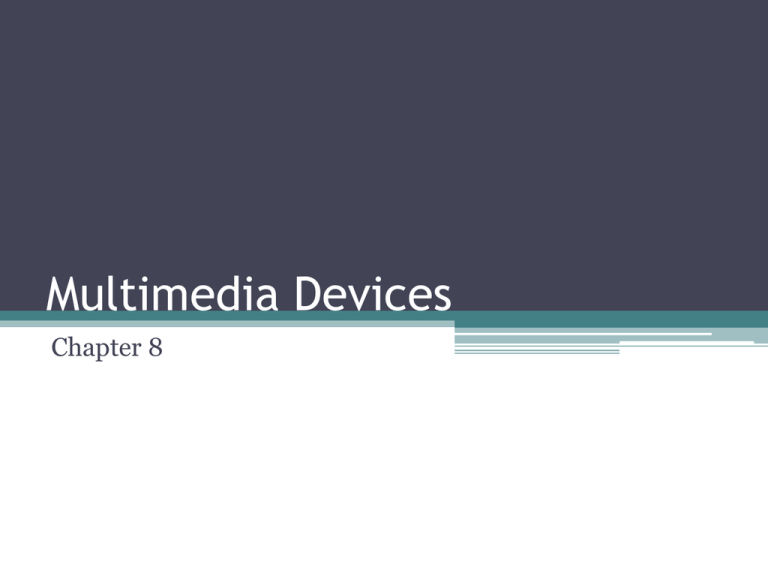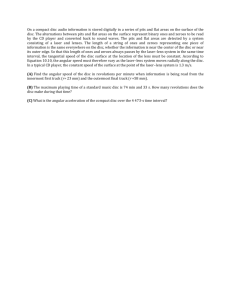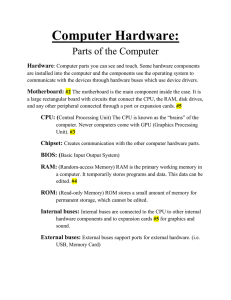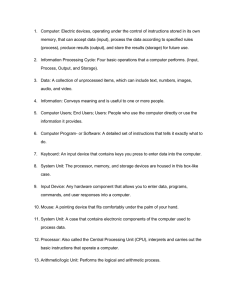Multimedia Devices
advertisement

Multimedia Devices Chapter 8 Multimedia Overview • The term multimedia has different meanings for people because there are many types of multimedia devices. This chapter focuses on the most popular areas—CD and DVD technologies, sound cards, cameras, and scanners. CD Drive Overview • A CD drive (compact disc) is sometimes called a CD-ROM (CD read-only memory) and it uses discs that store large amounts of information (628MB and higher). • The disc for the CD drive is known as a CD, CDROM disc, or simply disc. • Figure 8.1 shows a BenQ U.S.A. Corp.’s CD drive and its various front panel controls. • A CD has pits or indentations along the track. Flats, sometimes called lands, separate the pits. • Reading information from a CD involves using a laser diode or similar device. • The laser beam shines through the protective coating to an aluminum alloy layer, where data is stored. The laser beam reflects back through the optics to a photo diode detector that converts the reflected beam of light into 1s and 0s. • The transitions between the pits and lands create the variation of light intensity. • Figure 8.2 shows an inside view of a CD drive. CD Drive Speeds • CD drives come in a variety of types classified by the X factor: 1X (single speed), 2X (double speed), 32X, 48X, 52X, and higher. • Table 8.1 shows the transfer rates for several drive types. CD-R and CD-RW • Two CD technologies, CD-R (compact disc recordable) and CD-RW (CD rewritable) • Table 8.2 lists the different CD technologies. DVD Drives • DVD-ROM originally stood for digital video disc, then digital versatile disc. • DVD drives can be both internal and external devices connected to PATA IDE (internal), SATA IDE, SCSI, IEEE 1394 or USB. • The DVD-ROM drives currently come in two different configurations, 4.7GB and 8.5GB. The 4.7GB format (sometimes known as DVD-5) has a single layer of data on one side of the disc. • The 8.5GB capacity (known as DVD-9) uses two layers on the same side to increase storage capacity. • Two other capacities are 9.4GB and 17.1GB. The 9.4GB disc (also referred to as DVD-10) uses a single layer on both sides of the disc. • The 17.1GB disc (also known as DVD-18) has two layers on both sides of the disc. Other DVD Technologies • In addition to DVD-ROM, there are other types of DVD technologies currently in the marketplace: • Table 8.5 shows these technologies. Blu-ray Drives • Blu-ray is a development in optical disc technology that uses blue-violet laser technology rather than the red laser technology currently used by CD/DVD drives. • Blue-violet laser technology has a shorter wavelength, which means that smaller data pit sizes can be used to create higher disk capacities. • This laser technology is also more expensive than red laser. CD/DVD Drive Interfaces and Connections • CD and DVD drives can use PATA IDE, SATA IDE, eSATA, USB, and IEEE 1384. • In both desktop and portable computers, the IDE interface is the most common for internal devices and USB for external devices. Sound • Many sound cards have a MIDI (musical instrument digital interface) built into the adapter, and a jack for microphone input. MIDI is used to create synthesized music. • A 15-pin female connector on the back of the sound adapter connects a joystick or a MIDI device such as a MIDI keyboard. • Figure 8.8 shows a typical sound board and ports. Ports for speakers and headphones are typically 1/8" connectors that accept TRS (tip ring sleeve) cables. • S/PDIF (Sony/Phillips digital interface format) defines how audio signals are carried between audio devices and stereo components. • S/PDIF connectors can be used with coaxial cable (RCA jack) or fiber-optic cable (TOSLINK connector). Motherboards sometimes come with S/PDIF connectors. • Figure 8.9 shows the two types of S/PDIF connectors. • An initiative between Microsoft and Intel resulted in the PC Design Guides, which are available at http://www.pcdesguide.org. Connector colors and connector icons (labeling) are defined. • Figure 8.10 illustrates the recommended port icons relating to sound cards. • Table 8.6 shows common coloring used for sound ports. Scanners • A scanner is a popular input device that allows documents including text and pictures to be brought into the computer and displayed, printed, emailed, pressed to CD/DVD, and so on. • The most common types of scanners are listed in Table 8.8. • A scanned image can be saved in several formats. When scanning a document or graphic for Web pages, select JPEG or GIF format. • The most common graphic file formats are listed in Table 8.9. • There are many terms associated with scanning and Table 8.10 lists the most common. The end






